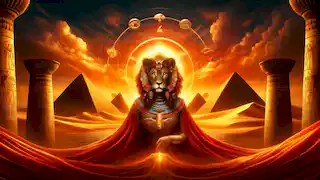In the heart of ancient Egypt, amidst the shifting sands and towering pyramids, a legend took root—one that spoke of gods, wrath, and redemption. This is the tale of Sekhmet, the lion-headed goddess of war, healing, and ferocious power. For centuries, the story of Sekhmet has been whispered in the corridors of temples and painted on the walls of tombs, embodying the divine balance between creation and destruction. Long ago, when the world was young and the Nile’s fertile waters gave life to the land, the gods ruled over all. Ra, the sun god, reigned supreme, his golden chariot blazing across the heavens each day. Yet, as humanity grew, so did their hubris. They turned away from the gods, questioning their might and neglecting their sacred duties. Ra, weary from his eternal vigilance and angered by the mortals' insolence, decided to teach them a lesson. From his divine essence, he summoned Sekhmet, a being of pure rage and unparalleled might. Her body was a vessel of fire, her mane a cascade of golden flames, and her roar echoed like thunder across the skies. Sekhmet descended upon the land, her fury unmatched. She swept across villages and cities, a force of nature that spared none. Fields burned, rivers turned red, and the cries of mortals echoed in vain. Yet, amidst the devastation, Ra began to question his actions. Had he gone too far? Humanity was not just rebellious but fragile, and their extinction would mean the gods’ purpose would falter. To temper Sekhmet’s wrath, Ra devised a cunning plan. He called upon his loyal followers and commanded them to brew a vast quantity of beer, mixing it with pomegranate juice to give it the appearance of blood. This intoxicating concoction was poured into the sands where Sekhmet roamed. Drawn by the sight of what she thought was her prey's blood, Sekhmet drank deeply. The divine brew clouded her senses, replacing her fury with a languid calm. Slowly, her bloodlust waned, and she fell into a deep, dreamless sleep. Ra, relieved at the success of his plan, allowed humanity to rebuild, teaching them to honor the gods and respect their divine power. When Sekhmet awoke, she found her wrath had subsided, but her purpose was unclear. Her transformation marked the beginning of her dual identity. No longer just a goddess of destruction, she became a protector and healer, a bringer of both death and life. Sekhmet’s priests built grand temples in her honor, where they sought her blessing to cure illnesses and to safeguard against enemies. Sekhmet's healing powers became as renowned as her fury. She was invoked during times of plague and warfare, her duality a reminder of the delicate balance between chaos and order. Worshippers would gather during her festival, offering hymns, food, and drink in hopes of earning her favor. One of Sekhmet’s most famous legends tells of a mortal woman named Nefret, a healer in the village of Thebes. When a mysterious illness swept through the region, even the most skilled physicians were powerless. In desperation, Nefret prayed to Sekhmet, offering her most prized possession—a golden amulet passed down through generations. Moved by Nefret's sincerity, Sekhmet appeared in a vision. She guided the healer to an ancient tree whose sap held curative properties. However, the goddess warned that the sap would only work if harvested under the moon's light, a time when its potency peaked. Nefret, undeterred by the challenge, ventured into the wilderness that night. As jackals howled in the distance and shadows danced under the silver moon, Nefret found the tree. She collected the sap and returned to her village, using it to craft a potent remedy. Her efforts saved countless lives, and the people of Thebes celebrated Sekhmet's compassion and Nefret's bravery for generations. To this day, Sekhmet remains a symbol of duality. Her myths remind us of the need for balance—between chaos and harmony, wrath and compassion, destruction and healing. As the lion-headed goddess, she embodies the fierce power that resides within us all, urging us to channel it wisely. {{{_04}}} The ancient Egyptians believed that Sekhmet’s spirit could still be felt in the searing desert winds and the gentle touch of a healer's hands. Her legend endures, etched in the annals of history, a testament to the gods’ power and humanity’s resilience.The Birth of a Wrathful Protector

The Turning Tide
Sekhmet’s Dual Nature

A Test of Mortality

The Eternal Balance
The Legend of Sekhmet
Reading Time: 4 min

About Story: The Legend of Sekhmet is a Myth Stories from egypt set in the Ancient Stories. This Dramatic Stories tale explores themes of Redemption Stories and is suitable for All Ages Stories. It offers Cultural Stories insights. The fierce goddess Sekhmet teaches the enduring lessons of balance, transformation, and redemption.

















